We look at each cider as a story. When we are making our ciders from the year's harvest we take the apples we are given, the characters, and try to blend into a particular story. Some might be more easy going, others might be more edgy. Making single varietal ciders subtracts the whole story and leaves us focusing on the character, which helps us to get to know the stars of the story - APPLES. -- Nate Watters, Keepsake Cidery
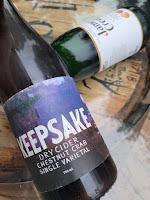 Most ciders on the market are blends of various cider apples sculpted to incorporate various aspects of each apple. But have you ever wondered about the unique characteristics of an individual apple variety? Is it sharp (acidic), sweet, tannic as depicted through the Long Ashton Research Station (LARS) classification?
Most ciders on the market are blends of various cider apples sculpted to incorporate various aspects of each apple. But have you ever wondered about the unique characteristics of an individual apple variety? Is it sharp (acidic), sweet, tannic as depicted through the Long Ashton Research Station (LARS) classification? By understanding the characteristics of each variety and adjusting production techniques accordingly, cider makers can craft complex and flavorful ciders that showcase the best of each apple. They must factor in the growing conditions of the apples as well as the yeast strains and fermentation temperatures.
For instance, there are key differences in growing conditions required for optimal flavor development in various single varietal cider apple varieties. These include:
- Climate: Cooler temperatures for sharp and full sharp varieties, moderate temperatures for traditional and modern varieties
- Soil: Acidic soils for bittersharp apples, well-draining soils for dessert apples
- Orchard style: Traditional cider apple varieties thrive in mature, high-density orchards with a mix of soil types and moderate climate conditions.
- Region: Cider apples grown in different regions, such as the Northeast, Mid-Atlantic, Midwest, and Northwest in the US, may require adjustments to growing conditions based on local climate and soil characteristics.
- Apple variety: Single varietal ciders made from heritage or traditional cider apple varieties may require specific growing conditions, such as cooler temperatures and higher acidity, to bring out their unique flavor characteristics. In contrast, ciders made from dessert apples may be more forgiving of varying growing conditions.
Snow Capped Cider must manage one set of these differing growing environments. The estate cidery is located at the bottom of The Grand Mesa -- the largest flat top mountain in the world. The orchards sit at elevation ranges between 6,130' - 7,000' and they trees are planted in fertile organic soils irrigated naturally by snow runoff. This natural condition maintains nutrients -- and along with the high amounts of U.V. exposure due to the altitude -- creates a very high sugar concentration in all of their fruit. Yet the conditions also encourage the development of tannins and acidity - balancing the sugars. Acidity from the diurnal temperatures and tannins from the fruit's ripeness.
Different yeast strains and fermentation temperatures can also significantly impact the final flavor profile of single varietal ciders. Yeast strains can introduce various flavor compounds, while fermentation temperatures affect yeast growth, enzyme activity, and the production of volatile compounds. By understanding the characteristics of different yeast strains and fermentation temperatures, cidermakers can experiment and tailor their processes to achieve specific flavor profiles, ultimately creating unique and complex ciders.
Here are a few single varietal ciders that we have sampled recently - most through the BevFluence Pomme and Perry Showcase.
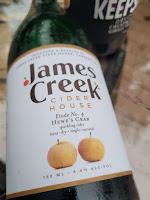 Hewe’s Crab was the most common fruit variety grown in eighteenth-century Virginia. It is thought to be a cross between the native American crabapple, Malus angustifolia, and the domesticated European apple. It produces a delicious cinnamon-flavored cider that is both sugary and pungent. Jefferson planted his entire north orchard exclusively with this variety and once wrote that crushing the juicy Hewe's Crab for cider was like "squeezing a wet sponge." Its small, round fruit, which ripens in September in Central Virginia, is dull red and streaked with green. (monticello.org)
Hewe’s Crab was the most common fruit variety grown in eighteenth-century Virginia. It is thought to be a cross between the native American crabapple, Malus angustifolia, and the domesticated European apple. It produces a delicious cinnamon-flavored cider that is both sugary and pungent. Jefferson planted his entire north orchard exclusively with this variety and once wrote that crushing the juicy Hewe's Crab for cider was like "squeezing a wet sponge." Its small, round fruit, which ripens in September in Central Virginia, is dull red and streaked with green. (monticello.org) The Hewe's Crab apple is considered Bittersharp with the bitter implying high tannins (polyphenols) and the sharp implying high acidity (malic acid). This is based on the Long Ashton Research Station (LARS) classification. The tannins and acidity can provide this cider the capability to age. We are holding back the James Creek Cider House Etude No 4 - Hewe's Crab to test that thesis, but for now this is a perfectly balanced cider in terms of acidity and tannins. The apples were sourced from Glaize Old Home Orchard (60%) and Kordick Family Farm (30%) - don't you love that type of information - and aged in French oak. This one is interesting in that there is a sense of the tropics - as in tropical fruit - in this delicious sparkling cider.
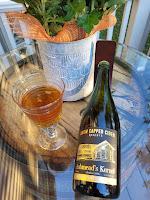 Ashmead's Kernel is an old English russet apple that originated from a seed planted around 1700 by Dr. Thomas Ashmead in Gloucester, England. The apple is lumpy, misshapen, and rather small with green and golden-brown skin, and a distinct crisp, nutty snap. Interestingly, Ashmead's Kernel is one of a few apple varieties from the Old World that succeeded in the New World. "When the first settlers arrived in North America they brought with them tried and tested varieties from Europe, yet few adapted to the very different climates of North America and most of the early successful American apple varieties were chance seedlings that evolved in America. However Ashmead's Kernel did thrive, and today holds a position of respect on both sides of the Atlantic..". -- Orange Pippen
Ashmead's Kernel is an old English russet apple that originated from a seed planted around 1700 by Dr. Thomas Ashmead in Gloucester, England. The apple is lumpy, misshapen, and rather small with green and golden-brown skin, and a distinct crisp, nutty snap. Interestingly, Ashmead's Kernel is one of a few apple varieties from the Old World that succeeded in the New World. "When the first settlers arrived in North America they brought with them tried and tested varieties from Europe, yet few adapted to the very different climates of North America and most of the early successful American apple varieties were chance seedlings that evolved in America. However Ashmead's Kernel did thrive, and today holds a position of respect on both sides of the Atlantic..". -- Orange PippenThe Snow Capped Cider 2020 Ashmead's Kernel is a nice representation of the apple as this Pet-Nat styled cider is made using apples grown in their high altitude Colorado orchards (6,130 feet), slowly fermented with natural yeast, and bottled before fermentation sis complete. This cider has a strong red delicious fresh cider flavor with plenty of juicy acidity and mild tannings.
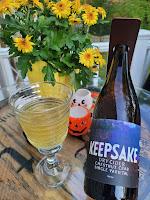 Chestnut Crabapple is a larger crabapple introduced at the University of Minnesota in 1949 as a cold hardy pollinator. However, the apple is one of the oldest in the University of Minnesota apple breeding program and was likely "the product of the original seed collected in 1907/1908 that founded the program". It is very disease resistant to the most common apple tree diseases such as apple scab, cedar apple rust, powdery mildew and fireblight. It's known to be sweeter and less tart than the smaller crabapples and that was the case with the Keepsake Cidery Dry Cider Chestnut Crab Single Varietal. This Pet-Nat styled cider was naturally fermented from fruit grown at the Gilchrist Orchard. Despite the dryness there is distinct nutty - apple flavors that mimic sweetness - with a blossoming apple aroma and sizzling texture that lingers long into the glass.
Chestnut Crabapple is a larger crabapple introduced at the University of Minnesota in 1949 as a cold hardy pollinator. However, the apple is one of the oldest in the University of Minnesota apple breeding program and was likely "the product of the original seed collected in 1907/1908 that founded the program". It is very disease resistant to the most common apple tree diseases such as apple scab, cedar apple rust, powdery mildew and fireblight. It's known to be sweeter and less tart than the smaller crabapples and that was the case with the Keepsake Cidery Dry Cider Chestnut Crab Single Varietal. This Pet-Nat styled cider was naturally fermented from fruit grown at the Gilchrist Orchard. Despite the dryness there is distinct nutty - apple flavors that mimic sweetness - with a blossoming apple aroma and sizzling texture that lingers long into the glass.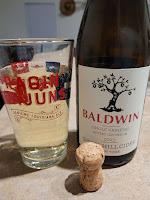 The Baldwin apple was introduced commercially around 1784 and by 1850 it was the Northeast’s most popular apple, more widely grown in the United States than any other variety. But a harsh winter in 1934 wiped out most of the Baldwin apple orchards leading to a waning in its popularity. Too bad, because its well documented history is fascinating. It is named after Colonel Loammi Baldwin, a Revolutionary War veteran who crossed the Delaware with Washington and commanded the Woburn Regiment during the Battle of Concord and Lexington; a fellow of the American Academy of Arts and Sciences; and he is known as the Father of American Civil Engineering through his canal construction. Plus he was a fervent apple grower and second cousin to John Chapman ("Johnny Appleseed"). The apple is often medium to large with skin that is yellow, flushed orange, and striped red. The flavor is sweet with crisp acidity. The South Hill Cider Baldwin is made using the traditional method champenoise. It is bone dry with lingering citrus notes and a refreshingly effervescent finish. In fact, the amount of citrus is surprising coming from a cider.
The Baldwin apple was introduced commercially around 1784 and by 1850 it was the Northeast’s most popular apple, more widely grown in the United States than any other variety. But a harsh winter in 1934 wiped out most of the Baldwin apple orchards leading to a waning in its popularity. Too bad, because its well documented history is fascinating. It is named after Colonel Loammi Baldwin, a Revolutionary War veteran who crossed the Delaware with Washington and commanded the Woburn Regiment during the Battle of Concord and Lexington; a fellow of the American Academy of Arts and Sciences; and he is known as the Father of American Civil Engineering through his canal construction. Plus he was a fervent apple grower and second cousin to John Chapman ("Johnny Appleseed"). The apple is often medium to large with skin that is yellow, flushed orange, and striped red. The flavor is sweet with crisp acidity. The South Hill Cider Baldwin is made using the traditional method champenoise. It is bone dry with lingering citrus notes and a refreshingly effervescent finish. In fact, the amount of citrus is surprising coming from a cider.
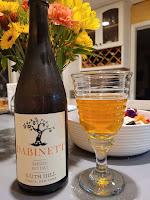 Dabinett is a British cider apple found by William Dabinett in the early 1900s growing as a wild seedling. It is a very reliable variety with high quality juice and is known for its strong aroma and distinctive flavor. The apples are small with red stripes often with red flush and makes a bittersweet cider which is mellow and full-bodied. "The tannins found in the flesh of these apples are the same substance found on the skin of wine grapes, which affects the flavor and acts as a stabilizer and natural preservative in both wine and cider" (Cider Scene) The South Hill Cider Dabinett Keeved 2022 is made in the traditional French keeving method to achieve a wild-fermented and naturally semi-dry cider. This process uses a slow 180 day fermentation after a cold maceration, and bottling before fully fermented to create a petillant naturel sparkling cider. This is such a unique cider both in terms of the fermentation method and the apple varietal. There are layers of complex flavors flowing through the tannic body - some tropical, some earthy funk, some black tea - very complex.
Dabinett is a British cider apple found by William Dabinett in the early 1900s growing as a wild seedling. It is a very reliable variety with high quality juice and is known for its strong aroma and distinctive flavor. The apples are small with red stripes often with red flush and makes a bittersweet cider which is mellow and full-bodied. "The tannins found in the flesh of these apples are the same substance found on the skin of wine grapes, which affects the flavor and acts as a stabilizer and natural preservative in both wine and cider" (Cider Scene) The South Hill Cider Dabinett Keeved 2022 is made in the traditional French keeving method to achieve a wild-fermented and naturally semi-dry cider. This process uses a slow 180 day fermentation after a cold maceration, and bottling before fully fermented to create a petillant naturel sparkling cider. This is such a unique cider both in terms of the fermentation method and the apple varietal. There are layers of complex flavors flowing through the tannic body - some tropical, some earthy funk, some black tea - very complex.
